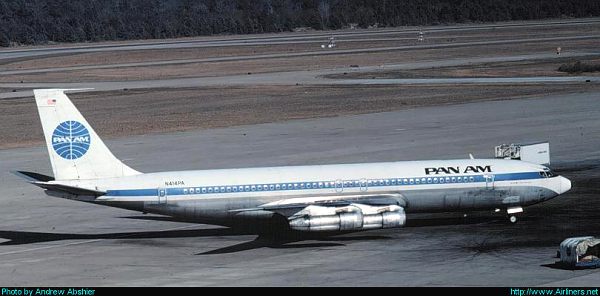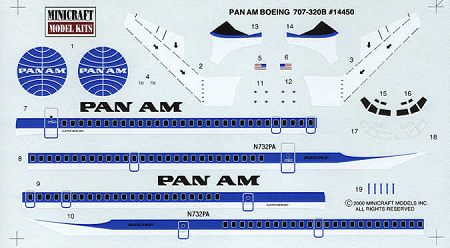
| KIT: | Minicraft Boeing 707-320B Intercontinental, 1/144th scale |
| KIT # | 14450 |
| PRICE: | $16.00 |
| DECALS: | Pan Am (mid-1970s titles) |
| REVIEW & PHOTOS BY: | Andrew Abshier, Oklahoma Historical Modelers Society (OHMS) |
| NOTES: |

|
|
Ask a kid to draw a jet airliner and most likely they will come up with something that looks like the Boeing 707: a long fuselage, swept wings, and podded engines underneath the wings. The 707 wasn't the first, or even second, jet airliner to enter revenue service (the De Havilland Comet I and Tupolev Tu-104 preceded it), but this aircraft, and the Douglas DC-8, largely defined what jetliners would look like to this day.
The first 707s were the shorter fuselage series 120s, which introduced American jet service to the world on October 26, 1958. The larger and improved series 320B first entered service in 1962. Passenger airline service in the United States continued with 707s until the early 1980s, when most were replaced with newer technology airliners such as Boeing's own 757 and 767 aircraft. Today a handful of 707-320Cs continue to fly, mostly on airfreight routes out of South America and Africa.
Pan Am was associated with the 707 from its first service in 1958 until
1981. Pan Am's last 707s operated Central American routes from Houston
Intercontinental Airport, and I was able to fly on them on two occasions.
The 707 always looked and sounded like the quintessential jet airliner, and
while people living near airports probably drank toasts when the last of these
smoky and noisy jets went out of service (or got re-engined with quieter
engines), enthusuasts still cheer every arrival of these increasingly rare
airliners.

Pan Am 707-321B in the final 707 color scheme at
Houston
Intercontinental Airport, August 1980 (Andrew Abshier)
|
THE KIT |
For many years, the only choice in 1/144th scale for a 707 Intercontinental was Airfix's ancient 707-420 kit. The Airfix model depicted a very early 707 Intercontinental with the earlier wing planform and nacelles with the organ pipe-like sound suppressors, and it took a lot of work to make it into a true 707-320B. Now, finally, Minicraft has come to the rescue with their latest airliner kit.
Like the Boeing 757 and 377 Stratocruiser, this kit was designed and tooled in China. While still not up to the very high standards being set in Korea, the Chinese toolmakers continue to improve with each kit, and this kit is definitely better than the 757 was.
The kit is molded in light gray. As has been customary with Minicraft's transport kits, no cabin windows are molded in the fuselage, but a large clear windshield piece is supplied. Surface detail is engraved; it is a touch heavy on the flying surfaces, but is commendably restrained on the fuselage. The fuselage doors and exits are set up for a 707-320C; if you're building a 320B you'll want to fill in the hatrack-to-floor exit that is positioned just behind the wing root.
Outline is generally accurate, for the most part.
Unfortunately the well-known Boeing windshield was not done well on this kit,
and the outline as given resembles a DC-6 more than a 707; reshaping will be
necessary, which will unfortunately necessitate use of a windshield
decal. Another error, but a much easier fix, is that the ventral fin
provided is the smaller type used on the earlier 707-120; the 320 ventral fin
should be twice the size.
A bit of sheet plastic and putty will put that
right quickly, but since most 320B/C aircraft didn't carry a ventral fin at all,
it is most likely a moot point.
There is an error in the instructions. The main gear doors on the fuselage are shown as single piece units that are open when the gear is down. These doors are actually bi-fold doors that are open only when the landing gear is cycling. When building your 707, cement these doors closed and scribe a line down the middle to represent the bifold area.
The distinctive outline of the later 707-320B wing is captured well; trailing edges on the wing parts are thick so some thinning will be necessary. There is a kink in the leading edge, right where the inboard engine struts are located; the kink is supposed to be there, but it is something I hadn't noticed before! The JT-3D turbofan engines are well rendered, and include fans for both the intake and exhaust. The 320B sprue also includes extra fans and sound suppressors for other engine types that Minicraft will subsequently be releasing, which should be useful for the spares box!
Component fit is generally good. Wing to fuselage fit is much improved
over the Stratocruiser and 757. There are plenty of liveries for the 707
on existing decals (such as the beautiful Ethiopian Airlines decals Scott
reviewed here recently) so there's no shortage of choices for this model.
|
DECALS |
 The decals were designed by Lloyd Jones of Scalemaster decals,
and are a mixed bag. One the one hand, they are sharply printed on
good-quality decal stock and are in near-perfect register. On the other
hand, a few mistakes were made with the livery, which suggests either laziness
or a lack of research. The Clipper name is in the wrong font; it should be
in a bolder, italicized font. Another point is that the hatrack-to-floor
size exit in the middle of decals 8 and 10 was not carried on the 707-320Bs Pan
Am used on passenger services. The printer also cut corners by
printing the 50-star field of the U.S. flags in Pan Am blue, which is wrong; the
field was always in a dark blue on Pan Am aircraft. The titles given are
from the early 1970s, with the more angular "tails" on the letters.
The decals were designed by Lloyd Jones of Scalemaster decals,
and are a mixed bag. One the one hand, they are sharply printed on
good-quality decal stock and are in near-perfect register. On the other
hand, a few mistakes were made with the livery, which suggests either laziness
or a lack of research. The Clipper name is in the wrong font; it should be
in a bolder, italicized font. Another point is that the hatrack-to-floor
size exit in the middle of decals 8 and 10 was not carried on the 707-320Bs Pan
Am used on passenger services. The printer also cut corners by
printing the 50-star field of the U.S. flags in Pan Am blue, which is wrong; the
field was always in a dark blue on Pan Am aircraft. The titles given are
from the early 1970s, with the more angular "tails" on the letters.
There has also been some discussion on the Airliner Model Digest that the blue may be wrong. Matching colors on airliners is always a nebulous business at the best of times so I'll say, from my own viewing of Pan Am 707s, that the blue is close to right.
Fortunately there have been aftermarket decals issued for the Pan Am 707s
already. FlightPath has a decal covering the 1960s airplanes with the full
"Pan American" titles, and Liveries Unlimited released a sheet some time ago for
the final 707 livery (as seen in the actual aircraft photo above). The LU
sheet is probably hard to find, but hopefully it will be reissued now that the
707 is out.
|
CONCLUSIONS |
Minicraft's airliners continue to improve with each outing and this 707 kit is a good one, with a generally accurate outline, good component fit, and fairly nice scribed detail. I know I'll be building more than one of these kits.
This kit also provides the first accurate base 707 model for the numerous
military versions of the 707-320B. A VC-137 has already been announced,
and Al Trendle, the president of Minicraft, has strongly hinted that other
military versions will follow--AWACS certainly, but one can hope for an E-6
Mercury and maybe an E-8 Joint-STARS to go with it also. An
ambitious modeler can do the Joint-STARS now, since the engines used on that
type are commercial JT3Ds, unlike the AWACS and the E-6 which use the TF-33 and
SNECMA CFM-56 engines.